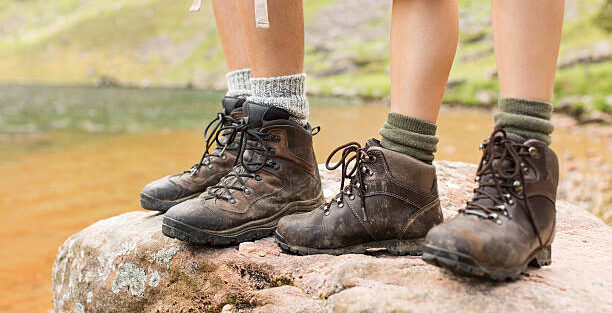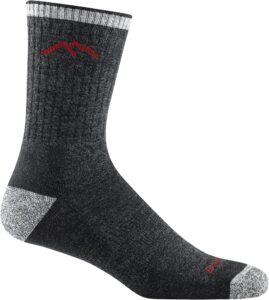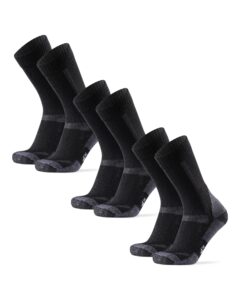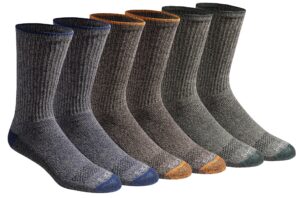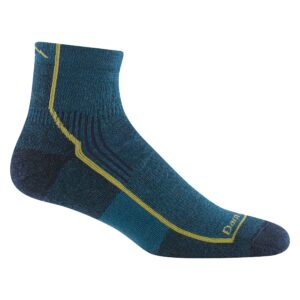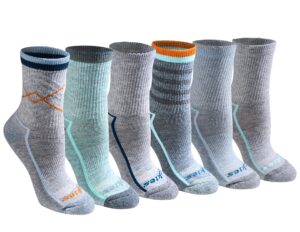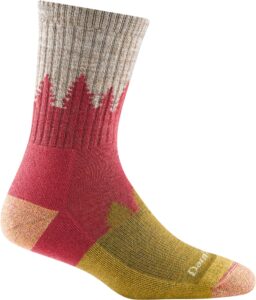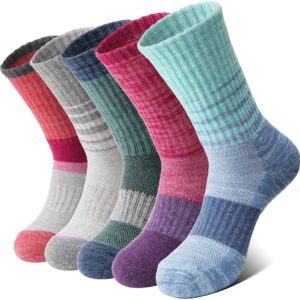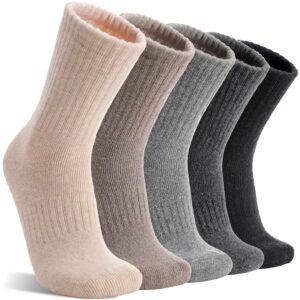Introduction:
Good hiking socks can make or break your trail experience. Your feet take thousands of steps, dealing with sweat, friction, and changing temps. Let’s get into what makes the best hiking socks.
The right hiking socks give you cushioning, moisture control, and blister prevention so your feet stay happy mile after mile.
Cotton socks just soak up sweat and stay wet, which is a recipe for blisters. Hiking socks use merino wool and synthetic blends to pull moisture away from your skin.
They also have cushioning in high impact zones and seamless toes to cut down on friction.
When you’re picking hiking socks, material, cushioning, and fit matter most. Merino wool naturally fights odors and helps regulate temperature.
Synthetics dry faster and tend to last longer. Cushioning goes from ultra-light for summer strolls to thick padding for big backpacking trips.
We tried out a bunch of hiking socks with different materials and cushioning to find the ones that really keep your feet comfy on the trail.
Best Hiking Socks
We tested a bunch of hiking socks to see which ones actually keep your feet dry and comfortable. Our favorites offer the best blend of cushioning, moisture control, and toughness for long hikes.
Darn Tough Hiker Socks
These socks feel incredibly comfortable and last forever. The lifetime guarantee makes the higher price a little easier to swallow.
Pros
- Lifetime replacement guarantee, no questions asked
- Merino wool keeps feet dry and comfy in any weather
- Cushioning is fantastic for long hikes
Cons
- Pricier than most hiking socks
- Drying time is a bit slow compared to synthetics
- Not a ton of color choices
The cushioning underfoot really matters, especially on rocky trails. Micro crew height works well with hiking boots and we never had them slip or bunch up.
No blisters or hot spots, even on long days. The seamless construction helps a lot with that.
The lifetime warranty is legit. We got a replacement for a pair with a hole and the process was quick and painless.
After dozens of hikes and washes, these socks still fit and look good. Merino wool actually handled temperature swings better than we expected.
They dry pretty fast, but synthetics win on that front. Still, for comfort and durability, these are hard to beat.
DANISH ENDURANCE Merino Wool Hiking Socks
If you’re a serious hiker and want blister-free feet, these are a solid pick.
Pros
- Merino blend wicks moisture and stays odor-free
- Targeted cushioning and arch support fight blisters
- Durable
Cons
- Sizing is a bit hit or miss
- More expensive than basic socks
- Fabric can pill with heavy use
The cushioning works! No hot spots or blisters after a 15 mile trek. Merino feels soft and doesn’t get stinky after a couple days, which is always nice.
Arch support gave us extra stability on rocky trails. Sizing ran a little large for us, so maybe order down if you’re unsure.
They wash well in cold water and air dry fast. After six months, ours still look decent with barely any wear at the heels or toes.
Dickies Dri-Tech Crew Socks
If you want decent hiking socks without spending a fortune, these get the job done.
Pros
- Moisture control keeps your feet reasonably dry
- Arch support stops sock slippage and foot fatigue
- Reinforced heel/toe hold up for months
Cons
- Sizing can be inconsistent
- Cotton blend holds some odor after heavy use
- Cushioning is thinner than the premium stuff
The moisture-wicking fibers work well on moderate hikes, keeping feet drier than regular cotton socks.
The arch compression is probably the best part. It hugs your foot without feeling too tight and stops bunching on steep climbs.
Honestly, the build quality surprised us for the price. Reinforced areas barely wore out after dozens of washes.
Ventilation helps, but during hot summer hikes, your feet will still sweat. At least they dry faster afterward.
Sizing was a bit weird. Some pairs felt much bigger than others. Double-check the size chart before buying.
Darn Tough Vermont Hiker Quarter Socks
These are built for hikers who need socks that’ll last and keep feet comfortable on long trails.
Pros
- Lifetime replacement guarantee
- Merino blend keeps feet dry and comfy in any weather
- Quarter height fits well with hiking boots and doesn’t rub
Cons
- Cost is higher than basic socks
- Drying time is a bit slow
- Medium cushioning might be too thick for some
Merino wool blend kept our feet comfy in both heat and cool mountain mornings.
Even after creek crossings, our feet dried out pretty quickly. The quarter height sits just above the boot, no rubbing or bunching.
Seamless toes meant no hot spots, even on long downhills. After months of use, the heel and toe still look nearly new.
And if you ever get a hole, Darn Tough replaces them. That’s tough to beat.
Dickies Women’s Dri-Tech Moisture Wicking Socks
These are a solid choice for day hikes or gym sessions. They manage sweat well but might feel too thin for serious backpacking.
Pros
- Great at wicking moisture during activity
- Good thickness for sneakers and boots
- Arch support feels nice on longer walks
Cons
- Not enough cushion for multi-day hikes
- Synthetics can get smelly faster than wool
- May be too lightweight for hardcore outdoor use
We wore these Dickies Women’s Dri-Tech socks on a few day hikes. They handled sweat surprisingly well, especially on steep climbs.
The ventilation channels worked in warm weather. Mid-crew height sits below the calf and doesn’t restrict movement.
Arch compression gave us extra support on rocky trails. Reinforced heel and toe areas held up against boot friction.
We’d use these for shorter hikes or gym workouts, not heavy backpacking. Cushioning is fine for day hikes, but you’ll want more padding for longer trips.
They wash and dry quickly, which is convenient. The synthetic blend keeps feet cooler than cotton but doesn’t fight odor as well as merino.
Overall, they’re ideal for casual hiking and everyday use. Not so much for tough expeditions.
Darn Tough Vermont Treeline Micro Crew Socks
These socks bring impressive comfort and real toughness for hikers who want gear that just won’t quit.
Pros
- Thick, plush cushioning keeps feet happy on long trail days
- Lifetime guarantee
- Merino wool blend wicks away sweat and keeps funky odors at bay
Cons
- Pricier than most basic hiking socks
- Colors sometimes look different in person than online
- Thicker fabric can feel a bit warm in hot weather
The merino wool blend is soft right out of the package, no scratchiness, just comfort.
The micro crew height lines up perfectly with our boots, and the socks never slipped down or bunched up. That’s a small thing, but it matters after a few hours on the trail.
The cushioning underneath makes rocky sections way less brutal. Our boots didn’t feel tight, either. After months of hikes and plenty of washes, these socks still look almost new. No thinning, no holes, nothing.
The seamless toe design is a lifesaver for avoiding blisters. We noticed that difference on longer days, for sure. Darn Tough’s lifetime guarantee is actually reassuring, even though, we haven’t needed it. If you hike a lot, these socks are worth the splurge, plain and simple.
Anlisim Merino Wool Hiking Socks
These merino wool socks bring cozy warmth and great padding for winter hiking. The wild tie-dye look isn’t for everyone, but they sure stand out.
Pros
- Super soft merino blend
- Wicks away sweat and keeps feet dry, even on tough climbs
- Solid arch support and cushy padding help prevent blisters
Cons
- Tie-dye colors are more about style than blending in outdoors
- Limited sizing
- Higher wool content means a higher price than synthetics
The padding around the heel and toe helps a ton on hard packed trails. After several washes, they haven’t shrunk or gotten fuzzy. That’s a relief, honestly. Getting five pairs in a pack is handy for multi-day hikes, no scrambling for clean socks at the last minute.
MOGGEI Women’s Merino Wool Hiking Socks
These wool blend socks keep feet toasty and comfortable on the trail. They’re soft, warm, and surprisingly breathable for cold-weather hikes.
Pros
- Wool blend feels soft
- Thick enough for warmth but not bulky inside boots
- Breathable, so feet don’t get sweaty
Cons
- Hand wash recommended
- Some batches seem a bit inconsistent in quality
- Only fits women’s sizes 6-10
We took these out on a few chilly hikes and liked how soft they felt right away. Our feet stayed warm on cold mornings, and we didn’t get that classic wool itch. The thickness is just right, and the socks stayed up all day.
After washing them in cold water, they didn’t shrink or lose color. The fuzzy lining inside traps warmth, which actually made a difference on frosty trails. The fabric breathes well, so our feet didn’t get swampy on uphill climbs. These work for hiking and just hanging out at home, honestly.
Buying Guide
When we’re shopping for hiking socks, a few features really make a difference out there.
|
Sock |
Material |
Cushioning |
Best For |
|
Darn Tough Hiker Socks |
Merino wool blend |
Medium cushioning |
All-weather comfort & durability |
|
DANISH ENDURANCE Merino Wool Hiking Socks |
Merino wool blend |
Targeted cushioning |
Blister prevention & arch support |
|
Dickies Dri-Tech Crew Socks |
Cotton blend with synthetics |
Light cushioning |
Budget hikers & casual use |
|
Darn Tough Vermont Quarter Socks |
Merino wool blend |
Medium cushioning |
Durable quarter height for boots |
|
Dickies Women’s Dri-Tech Moisture Wicking Socks |
Synthetic blend |
Light cushioning |
Day hikes & gym sessions |
|
Darn Tough Vermont Treeline Micro Crew Socks |
Merino wool blend |
Thick plush cushioning |
Long hikes with max comfort |
|
Anlisim Merino Wool Hiking Socks |
High merino wool blend |
Medium cushioning |
Cold-weather hiking with warmth |
|
MOGGEI Women’s Merino Wool Hiking Socks |
Wool blend |
Medium cushioning |
Women’s cold-weather hikes |
Material matters most. Merino wool keeps feet warm even when wet, and helps with odor. Synthetics dry fast and last longer. Skip cotton completely, unless you love blisters.
Cushioning changes the game for comfort. Go light for day hikes. Medium if you’re on rough trails. Heavy cushioning is best for backpacking or carrying a load.
Height depends on your boots and what you like. Crew socks pair well with mid boots. Boot socks fit high cut boots. No shows are for trail runners or low hikers.
Key Features to Consider
| Feature | What to Look For |
|---|---|
| Fit | Snug but not tight, no bunching |
| Seams | Flat or seamless toe construction |
| Thickness | Match to boot fit and activity |
| Durability | Reinforced heel and toe areas |
Fit matters more than we might think. Socks should hug your feet, but not squeeze them.
If they’re loose, you’ll get friction and hot spots. Nobody wants that on a long hike.
Moisture management is huge. Go for socks that actually wick sweat off your skin.
Dry feet mean fewer blisters and a way better day on the trail. Seriously, it’s worth it.
Think about your hiking style before buying. Day hikers usually want different features than backpackers.
The weather and terrain you’ll face most often should guide your pick. No sense in overthinking it, just match the sock to your adventure.
At the end of the day, the right pair of socks can make or break your hike. Choose well, and your feet will thank you later.
Support the Adventure
To make your walls less boring, check out my photography portfolio and bring a piece of the wild and my story into your home.
If you’d like to fuel future adventures, you can donate a coffee on Ko-Fi. Every cup keeps me chasing sunrises and stories.
When you shop using my affiliate links, every click helps support this blog at no extra cost to you. It’s a small way to keep Unicorn Adventure alive and kicking while I keep exploring.
Subscribe to my mailing list for future updates, new stories, and behind-the-scenes adventures.
Stay connected with me on Instagram and Facebook for more photos and daily inspiration.
Thanks for being part of the journey, Unicorn Squadron!


